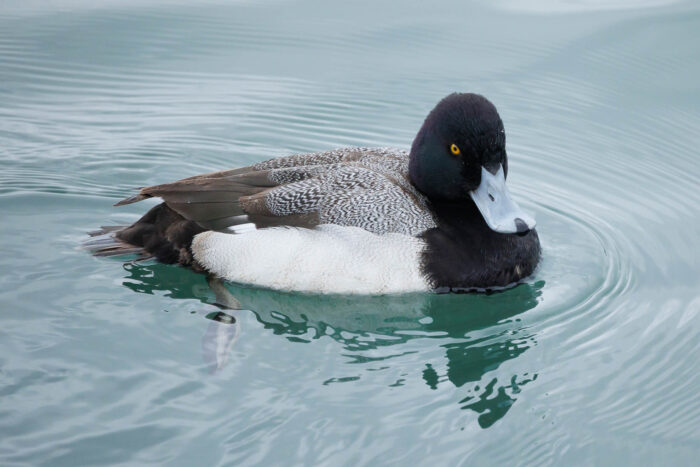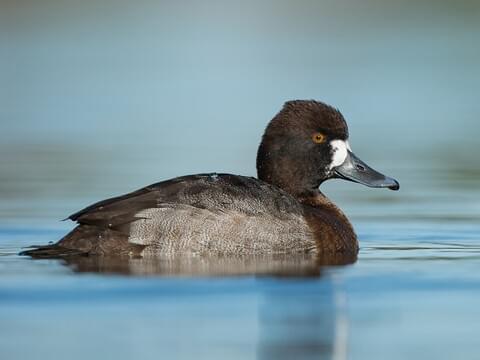Lesser Scaup


Scientific Name:
Aythya affinis
Alternative Names:
Lesser Scaup, Little Bluebill, Broadbill
Measurements:
| Feature | Male | Female |
|---|---|---|
| Length | 38–48 cm (15–19 in) | 38–48 cm (15–19 in) |
| Average Weight | 820 g (1.81 lb) | 730 g (1.61 lb) |
| Wingspan | 68–78 cm (27–31 in) | 68–78 cm (27–31 in) |
| Wing Length | 19–20 cm (7.5–7.9 in) | 19–20 cm (7.3–7.8 in) |
| Bill Length | 3.6–4.3 cm (1.4–1.7 in) | 3.6–4.3 cm (1.4–1.7 in) |
| Tarsus | 3.6–3.8 cm (1.4–1.5 in) | 3.6–3.8 cm (1.4–1.5 in) |
Status
Classified as Least Concern by the IUCN, though populations have been steadily declining since the 1980s. The decline’s cause is uncertain but may be linked to reduced breeding success, habitat changes, or food contamination from zebra mussels.
Identification
A small North American diving duck closely resembling the Greater Scaup. Males have glossy black heads with a purplish sheen, black breasts, light gray backs with fine vermiculations, white underparts, and black tails.
Females are dark brown with a white patch at the base of the bill. Both sexes have blue-gray bills tipped with a small black “nail” and gray feet. Males have bright yellow eyes, while females’ eyes range from orange to yellow.
Lesser scaup tend to have a more peaked crown and narrower bill than greater scaup, and their white wing bar is restricted to the secondaries rather than extending to the primaries.
Voice
Less vocal than dabbling ducks. Females give a raspy brrtt, brrtt or the characteristic “scaup” call. Males emit weak whistles during courtship.
Diet
Feeds mainly by diving and sifting through mud. Eats mollusks, crustaceans, aquatic insects, small fish, and seeds or roots of aquatic plants like pondweed, wild celery, and widgeon grass. In winter, they often feed heavily on zebra mussels, which may expose them to environmental contaminants.
Behavior
Forms flocks of 25–50 birds during migration and large rafts on wintering waters. Courtship occurs during winter or spring migration, leading to pair formation before reaching breeding grounds. Males leave after nesting begins to molt, while females alone incubate and raise the young.
Distribution
Breeds in North America from Alaska and western Canada south to Montana. Winters across the U.S., Central America, the Caribbean, and as far south as Colombia. Rare vagrants appear in Europe, Japan, Hawaii, and parts of South America.
Habitat
Breeds around freshwater lakes, ponds, and marshes in northern forests and tundra regions. Winters on freshwater or slightly brackish lakes, rivers, and sheltered coastal lagoons—rarely venturing offshore.
Breeding
Breeding begins in May or June, later than most North American ducks. Nests are shallow depressions lined with vegetation and down, placed near water among dense cover. Clutches average 9–11 eggs, incubated by the female for about 23 days. Ducklings fledge after 45–50 days. Some nests contain eggs from multiple females.
Wintering
Winters primarily in freshwater environments, including southern U.S. lakes, coastal lagoons, and Central American wetlands. Large numbers gather in Mexico’s Topolobampo lagoons and Colombia’s Ciénaga Grande de Santa Marta.
Conservation
Despite being the most abundant diving duck in North America, numbers have halved since the 1970s. The decline remains poorly understood, but possible factors include contaminants, shifts in food sources, and changing Arctic breeding conditions. Hunting and habitat loss are not considered major threats. The species remains listed as Least Concern but is monitored closely due to ongoing population decreases.
